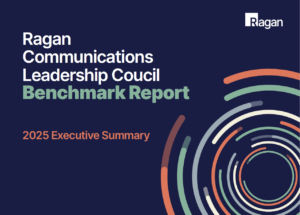What’s on communicators’ wish lists for the rest of 2025?
Break out of order-taker mode to deliver lasting value.

If you could make one change to your communications strategy, what would it be? It’s a simple question without an easy answer.
As part of Ragan’s 2025 Communications Benchmark Report, we asked a pool of more than 900 communicators worldwide to share their wishes. Analysis of the qualitative responses reveals a strong desire for communications to be more embedded in organizations’ strategic groundwork across a number of key areas.
The 2025 report, the seventh edition of this signature research project conducted for members of Ragan’s Communications Leadership Council, was released in March 2025. Here is a breakdown of what communicators had to say:
1. More executive buy-in and leadership support
Communicators are commonly frustrated by a lack of C-suite support. In many cases, that lack of buy-in leads to an order-taker mentality, with communicators caught in a self-perpetuating cycle of reactive response that gets in the way of becoming a valued business partner and strategic partner.
We need to “secure alignment in organizational prioritization with executive leadership and gain buy-in from the enterprise to follow strategy so we can effectively evaluate programming,” said one benchmark survey participant. “Coupled with that, proactively plan vs. reactively execute.”
Being able to effectively evaluate communications ties directly to the second item on the top of communicators’ wish list.
2. Better metrics and measurement
Communicators want more reliable data, analytics and KPIs to demonstrate the value of their work and break out of the cycle of call and response.
Better data comes with a double benefit. On one hand, it can tie comms efforts into business imperatives and demonstrate value to executives. On the other, it gives communicators tools and tactics to track the impact of their messaging and improve audience engagement and message clarity.
One comms professional summed it up this way: “Develop more granular metrics to ensure communications tactics map more closely to corporate/business objectives.”
3. More centralization and integration
One of the biggest frustrations communicators face is inconsistent and ineffective messaging. Often, this is because of a lack of coordination across business units. Organizations may benefit from centralized governance that ensures that teams work in alignment rather than isolation.
Here’s the advice from one survey participant: “Centralize communications across our very diversified business portfolio, and engage/influence leaders so they understand the criticality of unified and consistent communications.”
4. Increased budget and resources
According to benchmark data, lack of staff tops the list of barriers to more effective communications (45% of respondents). Lack of budget wasn’t too far behind (37%). Both numbers are higher than 2024.
While additional staff and deeper pockets would contribute to more effective, proactive communications, communicators can’t rely on them. They will need to be creative in a time of tightened budgets and uncertain business conditions. Smart investments in training and technology may help, as will more attention to the craft of communications.
“Invest more time, energy and resources into how we are communicating vs. what we are communicating,” said one survey respondent.
5. Invest more in training and skill development
Many professionals want more training. Key needs include strategic communications, AI, media relations and executive comms. Others mention the need for comms training for non-communicators to improve message consistency across the organization.
Here’s what one benchmark survey participant had to say: “Have better training for the team to unleash their communications talent and passion in a focused way guided, but not constrained, by senior management’s priorities.”
In times of uncertainty, learning and development serves a double purpose: It engages the individual in their job and shows commitment to their success, and it helps insulate the organization from the negative effects of change.
6. Clear comms strategy and planning
Better planning is the key to solving many of the challenges communicators face, from being more proactive to better strategic alignment and overcoming the flood of last-minute, ad hoc requests derail strategic priorities.
So, it’s no surprise that communicators want to create and enforce a clear communications strategy with advanced planning, defined priorities and executive alignment.
One useful tip from a survey participant: “Formalize dedicated time for thought and strategy work.”
7. Content and messaging
Overly corporate, dense communication styles are a turnoff when audiences are bombarded with engaging, multimedia formats and clear, action-driven messaging in their daily lives. Video, social media and AI-assisted content creation are all ways to help address the challenge.
Again, connecting content and messaging to business value can help solve the problem. If professional communicators are seen as valued, results-oriented business partners, then they can turn loose their talents to create more engaging and effective communications.
“Give the communications team greater control over messaging and strategic direction,” pleaded one survey participant.
Achieving that goal will require consistently delivering and measuring value against business priorities. And it will turn the desire to be more strategic from a wish to a reality.
The full 77-page report, based on a survey of more than 900 communicators worldwide, is available exclusively to members of the Ragan Communications Leadership Council.






